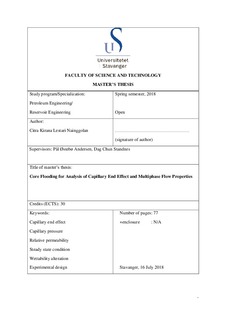| dc.contributor.advisor | Andersen, Pål Østebø | |
| dc.contributor.advisor | Standnes, Dag Chun | |
| dc.contributor.author | Nainggolan, Citra Kirana Lestari | |
| dc.date.accessioned | 2018-10-24T06:42:36Z | |
| dc.date.available | 2018-10-24T06:42:36Z | |
| dc.date.issued | 2018-07 | |
| dc.identifier.uri | http://hdl.handle.net/11250/2569217 | |
| dc.description | Master's thesis in Petroleum Engineering | nb_NO |
| dc.description.abstract | The non-uniform saturations along the core is called capillary end effect. The capillary end effect is caused by the condition that the capillary pressure is zero outside the core. The presence of capillary end effect is significant in the laboratory. The determination of relative permeability and capillary pressure curves are much affected by capillary end effect. Capillary end effect influences the determination of end point saturation (residual oil saturation). The objective of this thesis is to estimate relative permeability and capillary pressure curves from the experiment to get a better understanding on capillary end effect by performing wettability alteration on the core samples that initially strong water-wet, spontaneous imbibition, forced imbibition(water-flooding), simulation of the experiment using simulator SENDRA, and sensitivity using simulator SENDRA. Wettability alteration is performed to change the wettability from water-wet to more oil-wet since capillary end effect is significant in more oil-wet state at water-flooding. Spontaneous imbibition is conducted to have a core system which has water saturation at P_c equal to zero. Forced imbibition is done by applying several rates to the core until it reaches a steady-state condition. Steady-state is reached when oil is perfectly immobilised due to entrapment, and the rate of injected water is equal to the rate of produced water (Virnovsky et al., 1995; Andersen et al., 2017). Cumulative oil and the differential pressure is measureed to estimate the relative permeability and capillary pressure curves by using simulator SENDRA. By conducting sensitivity in SENDRA, the main parameters that have a significant impact on capillary end effect are wettability, absolute permeability, rate, water viscosity and length of the core. | nb_NO |
| dc.language.iso | eng | nb_NO |
| dc.publisher | University of Stavanger, Norway | nb_NO |
| dc.relation.ispartofseries | Masteroppgave/UIS-TN-IEP/2018; | |
| dc.subject | petroleumsteknologi | nb_NO |
| dc.subject | petroleum engineering | nb_NO |
| dc.subject | capillary end effect | nb_NO |
| dc.subject | capillary pressure | nb_NO |
| dc.subject | relative permeability | nb_NO |
| dc.subject | wettability alteration | nb_NO |
| dc.subject | steady state condition | nb_NO |
| dc.subject | experimental design | nb_NO |
| dc.title | Core Flooding for Analysis of Capillary End Effect and Multiphase Flow Properties | nb_NO |
| dc.type | Master thesis | nb_NO |
| dc.subject.nsi | VDP::Teknologi: 500::Berg‑ og petroleumsfag: 510::Petroleumsteknologi: 512 | nb_NO |
